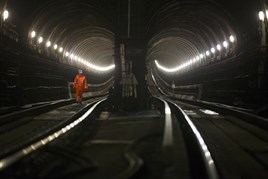It is surreal to think that a river is above us, just a few feet away from where we stand, and even more so when you contemplate the thought processes that led to such an engineering triumph.
Early in the 19th century, additional crossings on the Thames were desperately needed, particularly around London Bridge and the East End, where the docks were rapidly expanding. Congestion on both the roads and the river itself meant that the only option was underground.
Many had tried, but each attempt failed because of the soft nature of the ground, which eventually led engineers to the conclusion that going under the river just wasn’t practical.
But Marc was not prepared to accept such a grim outlook, and set about developing new ways to dig a tunnel. By January 1818, he had teamed up with Lord Thomas Cochrane (a successful Napoleonic admiral), and had come up with the ingenious idea for a tunnelling shield… inspired by the most unlikely creature.
While working at Chatham Dockyard, he examined a piece of timber that had been removed from the keel of a ship, and found that it was riddled with holes. The culprit was said to have sunk more ships than enemy cannons, and yet was only nine inches in length.
The mollusc teredo navalis was a shipworm able to bore through the hardest oak. Having observed its methods, Brunel and Cochrane filed a patent for ‘forming drifts and tunnels underground’. The pair had designed the tunnelling shield - the forefather of the tunnel boring machine.
Just five years later, the plan was conceived to tunnel downstream from London Bridge (linking Rotherhithe and Wapping), setting in motion the project to construct a tunnel intended for foot passengers and eventually carriages.
Under Marc’s guidance, construction began in 1825. But there was a reason that attempts by others to tunnel under the Thames had failed… it was a risky and highly dangerous process.
Workers were frequently showered with water polluted by raw sewage. Miners’ oil lamps often ignited pockets of methane or marsh gas, producing lethal flames. By the end of the project, miners could only work two-hour shifts at a time before they collapsed from lack of fresh air. If a worker collapsed, he was simply replaced by a man who was still breathing.
Marc’s son, Isambard, directed much of the work, and he was well respected by the miners for tirelessly working alongside them, despite the awful conditions and on several occasions at the expense of his own health. He even saved several lives when leaks and breaches occurred during construction.
Nothing would deter the Brunels’ determination. During its early years, the project suffered from a lack of funding, and Marc needed to find a way to inspire new investors. So, on November 10 1827, Isambard organised a banquet in the new tunnel. It was described as the first underwater banquet in the world - solid silver settings, crystal glass and the band of the Coldstream guards set the scene, to prove to the guests that the tunnel was safe and worthwhile.
For us now, standing on the spot where the banquet took place, it’s not difficult to imagine the deafening sound that a brass band would have made in such an ‘echoey’ environment. And the plan worked - new investors were signed up and the project was able to continue.
But the elation was short-lived. Eleven weeks later, a terrible flood in the tunnel killed six workers, and Isambard was injured in a way from which he would never fully recover. However, not even this was enough to stop them. Isambard continued to direct the rescue operation and examination of the breach from a mattress on the deck of a barge, leading to the press later praising him for his “intrepid courage and presence of mind”.
Despite such dogged determination, money again ran out just a few months later. Marc was forced to stop work on the tunnel, having it bricked up until funds could be raised to continue. It took seven years to find new investors, and it wasn’t until December 1834 that he succeeded, by which time the original tunnelling shield had rusted and needed replacing with a new (more robust) version.
Having been beset by several serious floods, fires, gas leaks and human loss, the tunnel was eventually completed in November 1841. The project had been surrounded by controversy, but on March 25 1843, the tunnel was finally fitted out and opened to the public.
The tunnel shaft, situated 150ft (46m) from the riverbank, became known as the Grand Entrance Hall. It stands right outside the Brunel Museum in that quiet residential district in Rotherhithe. The shaft now has a concrete floor inside - it was installed by Transport for London in 2010 to allow visitors to enter it, although to reach it you still have to squeeze through a tiny doorway only 4ft tall and wind your way down a temporary staircase.














Login to comment
Comments
No comments have been made yet.